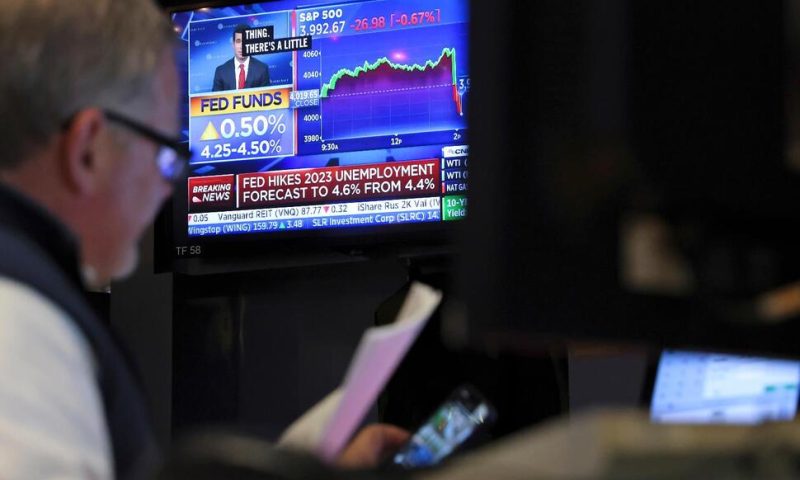Stocks ended lower in bumpy trading on Wall Street after the Federal Reserve raised its benchmark interest rate in its fight against inflation and signaled that more hikes lay ahead
A bumpy day of trading on Wall Street ended with stocks broadly lower Wednesday after the Federal Reserve raised its benchmark interest rate in its fight against inflation and signaled that more hikes lay ahead.
As expected, the central bank raised its key short-term rate by 0.50 percentage points, marking its seventh hike this year. The Fed also said it expected rates would be higher over the coming few years than it had previously anticipated.
The S&P 500 lost 0.6% after giving up an earlier gain of 0.9%. The Dow Jones Industrial Average fell 0.4% and the Nasdaq composite gave back 0.8%. Bond yields mostly fell after a brief rally following the Fed’s midafternoon announcement.
“The market was expecting the Fed to tone down its hawkishness, which it did not,” said Sam Stovall, chief investment strategist at CFRA.
The Fed’s latest hike is smaller than the previous four 0.75 percentage point increases and comes a day after an encouraging report showed that inflation in the U.S. slowed in November for a fifth straight month.
Recent signs that inflation, while still painfully high, has eased had stoked optimism on Wall Street that the Fed might signal the possibility of rate cuts in the second half of next year. But during a press conference following the Fed’s latest policy announcement, Fed Chair Jerome Powell emphasized that the full effects of the central bank’s efforts to slow the economy to bring down inflation have yet to be fully felt.
“The inflation data received so far for October and November show a welcome reduction in the monthly pace of price increases, but it will take substantially more evidence to give confidence that inflation is on a sustained downward path,” Powell said.
Powell also reiterated that the Fed plans to hold rates at a level high enough to slow the economy “for some time” to ensure inflation really is crushed. He said the Fed’s projections released Wednesday do not include any for rate cuts in 2023.
“I wouldn’t see the committee cutting rates until we’re confident that inflation is moving down in a sustained way,” Powell said.
He also said that how fast the Fed raises rates is not so important now. “It’s far more important to think what is the ultimate level,” Powell said.
The latest increase brings the Fed’s federal funds rate to a range of 4.25% to 4.5%, its highest level in 15 years. Fed policymakers forecast that the cental bank’s rate will reach a range of 5% to 5.25% by the end of 2023. That suggests the Fed is prepared to raise rates by an additional 0.75 percentage points next year.
The Fed also signaled it expects its rate will come down by the end of 2024 to 4.1%, and drop to 3.1% at the end of 2025.
“This is considerably higher than expectations priced into financial markets, which are positioned for the federal funds rate to come back down to 3.9% at the end of 2023 and to 2.6% at the end of 2024,” said Bill Adams, chief economist for Comerica Bank.
Bond yields wavered for much of the afternoon as traders digested the Fed’s action. The yield on the 10-year Treasury, which influences mortgage rates, slipped to 3.48% from 3.50% from late Tuesday. The two-year yield, which more closely tracks expectations for Fed moves, held steady at 4.22%.
Wall Street has been closely watching economic reports on consumer spending and employment, which remain strong. That has made it more difficult for the Fed to tame inflation while also helping to protect the slowing economy from a possible recession.
The U.S. will release its weekly report on unemployment benefits on Thursday, along with retail sales data for November.
Roughly 70% of the stocks in the S&P 500 closed lower Wednesday, with technology companies, banks and retailers among the biggest weights on the benchmark index. Apple fell 1.6%, Goldman Sachs dropped 2.3% and Best Buy slid 3.9%.
All told, the S&P 500 fell 24.33 points to 3,995.32. The Dow slid 142.29 points to 33,966.35, and the tech-heavy Nasdaq fell 85.93 points to 11,170.89.
Small company stocks also fell. The Russell 2000 index slid 11.91 points, or 0.7%, to 1,820.45.
Delta Air Lines rose 2.8% after it raised its fourth-quarter financial outlook and issued an optimistic forecast for 2023.

